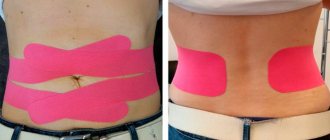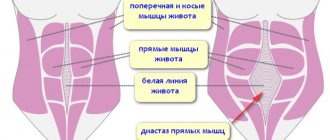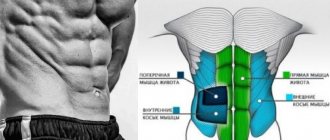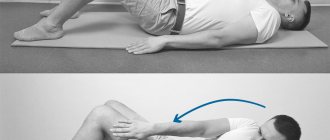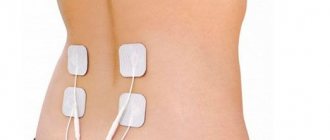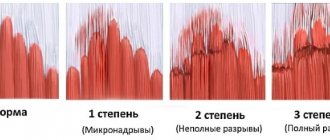What is this?
As we noted above, behind this diagnosis lies nothing more than a separation of the rectus abdominis muscles. And it just so happened that the main reason for its appearance is pregnancy.
During this exciting period, the constantly growing baby puts pressure on the anterior abdominal cavity, literally stretching the abdominal muscles. The hormone relaxin, the main task of which is to increase the elasticity of ligaments and joints, which simplifies the process of childbirth, adds fuel to the fire of the formation of the disease.
Based on the above, it can be determined that all pregnant women are at risk. But most often, diastasis occurs in women with large, multiple pregnancies, polyhydramnios, second and subsequent births, unfavorable heredity, problems with posture, and in overweight women in labor.
Maternity capital in 2021
What can you spend the money on, and what is the payout amount?
Go to article
Diagnostics
Vyacheslav Vladimirovich, tell us what diastasis of the rectus abdominis muscles is and what is its insidiousness?
V.V Mute : Diastasis is stretching or thinning of the tendon plate between the rectus abdominis muscles, the so-called linea alba, which leads to muscle separation. The fact is that during pregnancy, under the influence of the hormone relaxin, the muscles of the anterior abdominal wall atrophy so that the abdomen and uterus have the opportunity to stretch along with the growth of the fetus. After the baby is born, the hormone production stops and the muscles gradually recover. Connective tissues remain at risk - tendons, which do not always have enough elasticity to return to their previous state. As a result, a discrepancy forms between the muscles, which is called diastasis. Figuratively speaking, diastasis resembles lightning that has spread down the center. The insidiousness of diastasis is that despite possible serious consequences, leading, for example, to prolapse of internal organs, the patient does not experience any pain or other symptoms. All that can cause concern is the appearance of the stomach.
Does diastasis threaten every woman who gives birth? Or are there those who have a wider location?
V.V. Mute : Diastasis cannot be called a problem on a global scale. About 15% of women who give birth with the joy of motherhood also receive such a nuisance as diastasis. The reason for the appearance of diastasis in some women and the absence in others lies in connective tissue dysplasia syndrome. Dysplasia is not a pathology, but only a feature of collagen tissue. It is these patients who develop hernias more often, and their tendons are more subject to stretching.
Doctor, tell us about the clinical course of diastasis? Is it asymptomatic or may it be accompanied by painful sensations?
V.V. Mute : A distinction must be made between diastasis recti and hernia of the anterior abdominal wall. The anterior abdominal wall has soft and hard membranes. A hernia is a disorder, a splitting of the hard membranes. With diastasis, the integrity of the hard shells is preserved; they only stretch and become very thin. The patient does not experience any pain or discomfort. The only thing that might bother you is the appearance of your belly. The muscle divergence can reach up to 10 cm in width and about 12 cm in length. With such a discrepancy, a “pregnant belly” effect can be created.
There are 3 degrees and 3 types of diastasis of the rectus abdominis muscles . If a muscle discrepancy of 1-2 cm in width is considered normal, then:
1st degree of diastasis - muscle discrepancy up to 5 cm;
2nd degree of diastasis - muscle discrepancy 5-7 cm;
Stage 3 diastasis – muscle separation greater than 7 cm.
3 types of diastasis:
- above the navel;
- below the navel;
- mixed type (presence of muscle divergence both above and below the navel).
How to determine?
Only a doctor can make an accurate diagnosis, but you can conduct a preliminary diagnosis yourself.
- Lie on the floor, bend your legs, press your feet tightly, moving your heels towards your buttocks. Raise your head and shoulders so that your abdominal muscles are tense (as if you are pumping your abs), place one hand behind your head.
- With your other hand, feel the midline of the abdomen and the muscles radiating from it (feel like rollers).
- Use your fingers to determine the width of the strip between the muscles near the navel.
It is customary to distinguish three stages of diastasis, depending on the size of the muscle discrepancy:
- 5-7 cm. This degree is quite common after the first birth. Usually it does not bring any problems to a woman, but sometimes it can be accompanied by abdominal discomfort.
- More than 7 cm. At this stage, the lateral abdominal muscles relax.
- More than 10 cm. A dangerous situation for health, the skin becomes saggy, hernias and muscle atrophy may occur.
As you might guess, the treatment method for diastasis depends on its degree. If the first and second stages can be dealt with naturally with the help of exercises and corrective gymnastics, then the third stage will most likely require surgery.
Typically, the two vertical abdominal muscles at the front pull apart during pregnancy, creating a gap—this is called diastasis recti. This discrepancy can result in a bulge, usually below the navel.
The size of the discrepancy varies from woman to woman, but after giving birth, be careful with any exercises that cause you to stick out your belly: squats, planks and straight leg raises. This may further increase the discrepancy.
Your doctor may check your stomach to see if you have diastasis. Often the muscles reconnect within a few months after giving birth. However, at least one in three women still have diastasis six months after giving birth.
If your abdominal muscles are still separated from each other after eight weeks, ask your doctor to refer you to a physical therapist. Your physical therapist will show you exercises you can do to help your abdominal muscles grow back together.
What increases the likelihood of rectal diastasis after childbirth?
Research suggests you may be more likely to get diastasis if you:
- gave birth more than once
- you had twins or more
- you have had more than one caesarean section
- you gave birth at an older age, when muscles are naturally weaker
- regularly strained your abdominal muscles during pregnancy due to frequent heavy lifting, chronic coughing, or vomiting
It's likely that diastasis can run in families, so if your mother or sister has it, you're more likely to get it too.
How can I tell if I have diastasis after giving birth?
If your stomach feels very flabby after you've had your baby, it may be because your abdominal muscles are still separated. If so, you may notice a bulge in the front of your belly. The bump may be around the belly button, just above or below the belly button, or along the entire midline. It's very common for your abdominal muscles to separate immediately after giving birth.
If you're not sure if you have diastasis, here's how to check:
- Lie on your back with your knees bent and your feet flat on the floor or bed.
- Place your palm on your stomach, just below or above your navel.
- Lift your shoulders slightly off the floor and look down at your stomach. Using your fingertips, feel between the edges of the muscles, both above and below the navel.
- See how many fingers you can fit into the space between the muscles. If the gap is more than two fingers wide, you may have diastasis. The width depends on the size of your diastasis. Do the test regularly; as your muscles get stronger, the gap decreases.
How can you help yourself with diastasis direct?
If 8 weeks have passed and your diastasis has not improved, your doctor should refer you to a physical therapist.
A physical therapist will work with you to:
- Your posture helps you maintain a relaxed, neutral spine.
- How you move – Avoid movements that increase intra-abdominal pressure. For example, you may want to roll onto your side to get up from a lying position and avoid straining on the toilet.
- Your breathing - using your diaphragm and expanding your chest as you breathe.
- Exercises to strengthen your abdominal muscles , including pelvic floor exercises, before moving on to exercises for your outer core.
Is it possible to have surgery to correct rectal diastasis after childbirth?
Not all women will need surgery. Physical therapy may be enough to help your abdominal muscles knit back together. However, surgery to correct diastasis after childbirth may be a solution if:
- Your diastasis is serious.
- You do not plan to become pregnant again.
- You've done all you can with physical therapy, but you're still struggling with diastasis.
If you are overweight, your doctor will likely advise you to lose weight before surgery.
During surgery, your surgeon will re-suture the abdominal wall muscles along the midline. He can use mesh to reinforce the seams.
In some cases, the surgeon may perform the procedure laparoscopically, using a tiny camera and instruments inserted through small incisions. But if your diastasis is very severe, your doctor may recommend open abdominal surgery. This means a larger incision and a longer recovery period.
Read here what to do to avoid long-lasting diastasis.
Abdominoplasty
In some cases, diastasis can only be removed surgically. Do not forget that without treatment the disease will progress, which can lead to an even greater expansion of the line, loss of waist, growth of a “pregnant” tummy, prolapse of internal organs, urinary incontinence, etc. It is important to note that such plastic surgery is not a contraindication for subsequent pregnancy .
Let's talk about modern methods of treating diastasis.
Abdominoplasty
A procedure in which excess skin and fat are removed and the abdominal muscles are returned to their original position. There are several types of such intervention:
- Mini abdominoplasty. Excision of excess skin, correction of the lower abdominal wall.
- Standard. Suturing of muscles, tightening of skin, in some cases correction of the navel area.
- Endoscopic. Used when suturing muscles without removing excess skin is required.
Hernioplasty
A procedure indicated for patients who develop hernias due to divergence of the abdominal muscles. There is an open method of hernia repair, when the intervention occurs through a small incision, and an endoscopic method, with the elimination of pathology through an opening in the abdominal wall.
In addition, hernioplasty can be:
- Stretch using your own fabrics.
- Tension with the use of a mesh implant - endoprosthesis.
- Combined, combining both methods.
In our city, several companies offer diastasis treatment services. Let's talk about some of them:
- Institute of Medical Cosmetology, st. Kirova, 19, t. 212-09-75
- Krasnoyarsk Center for Plastic Surgery and Outpatient Medicine, Mira Ave., 93, t. 211-21-13
- Krasnoyarsk Institute of Traumatology, st. Mechnikova, 49, t. 22-33-999
- Effi, st. Historical, 111 art. 3/2
Reviews, photos and prices for abdominoplasty and hernioplasty in Krasnoyarsk can be found on the companies’ website.
In any case, a woman should make a decision about surgery and the technique used together with her doctor. The main thing is not to let the problem take its course and contact specialists in a timely manner.
THERE ARE CONTRAINDICATIONS, SPECIALIST CONSULTATION IS REQUIRED
